The Moisturizing Body Creams Market is expected to record a valuation of USD 12,402.8 million in 2025 and USD 24,806.4 million in 2035, with an increase of USD 12,403.6 million, which equals a growth of 100% over the decade. The overall expansion represents a CAGR of 7.2% and a 2X increase in market size.
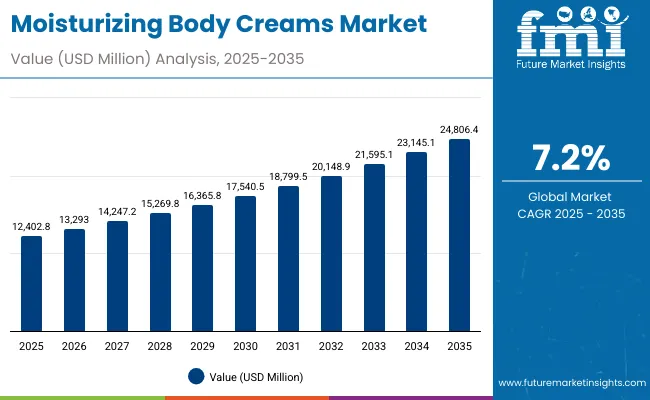
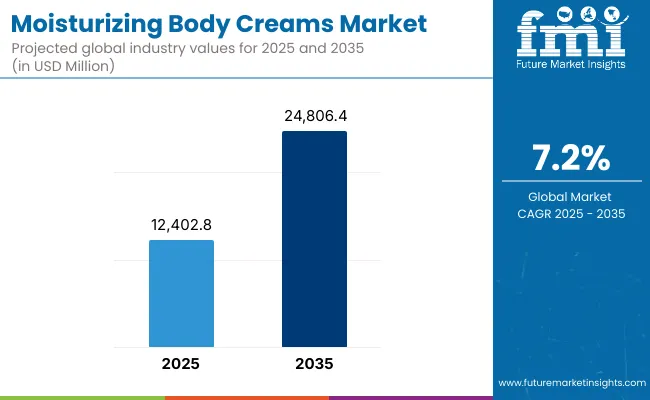
Moisturizing Body Creams Market Key Takeaways
| Metric | Value |
|---|---|
| Moisturizing Body Creams Market Estimated Value (2025E) | USD 12,402.8 million |
| Moisturizing Body Creams Market Forecast Value (2035F) | USD 24,806.4 million |
| Forecast CAGR (2025 to 2035) | 7.2% |
During the first five-year period from 2025 to 2030, the market increases from USD 12,402.8 million to USD 17,540.5 million, adding USD 5,137.7 million, which accounts for 41.4% of the total decade growth. This phase records steady adoption of hydrating body lotions, rich body butters, and repair creams, driven by demand for deep hydration and enhanced skin barrier repair. Women remain the leading end-user segment, representing over 63.6% of total value, with growth supported by product innovation and sensory-driven formulations.
The second half from 2030 to 2035 contributes USD 7,265.9 million, equal to 58.6% of total growth, as the market rises from USD 17,540.5 million to USD 24,806.4 million. This acceleration is powered by e-commerce expansion, clean-label actives such as shea butter and ceramides, and personalized moisturizing solutions. Premium and dermatologically tested products gain momentum, while smart retail and digital engagement enhance consumer conversion rates across emerging regions.
From 2020 to 2024, the Moisturizing Body Creams Market expanded steadily, driven by the increasing adoption of hydrating lotions and repair creams across mass and premium retail channels. During this period, legacy brands such as Nivea and Vaseline dominated category revenue, collectively accounting for nearly 30% of global sales.
Competitive differentiation relied on ingredient transparency, sensory appeal, and sustained hydration performance, while digital commerce and subscription models remained nascent. Service-based skincare consultations and personalization accounted for less than 10% of total value.
Demand for Moisturizing Body Creams will expand to USD 12,402.8 million in 2025, and the revenue mix will shift as e-commerce and clean-label innovations gain traction. Traditional mass brands face rising competition from dermatologist-led and natural formulation companies offering AI-based skin diagnostics, sustainably sourced actives, and subscription-driven supply models.
Major brands are pivoting to hybrid distribution strategies that blend digital engagement with retail presence to retain share. Emerging entrants focused on bioactive formulations, vegan ingredients, and personalized care are gaining momentum, shifting competitive advantage from legacy brand heritage to innovation, sustainability, and consumer loyalty ecosystems.
The Moisturizing Body Creams Market is expanding as consumers increasingly seek products that deliver long-lasting hydration, repair damaged skin barriers, and combat dryness caused by environmental stress and lifestyle factors.
Growth is particularly driven by formulations containing humectants like hyaluronic acid and occlusives such as shea and cocoa butter. Additionally, dermatologically tested and fragrance-free variants are gaining traction among consumers with sensitive skin, further boosting adoption across both premium and mass-market skincare segments worldwide.
Rapid digitalization of beauty retail and consumer preference for transparent, ingredient-led formulations are fueling market growth. Online platforms enable global access to premium moisturizing body creams, driving sales through direct-to-consumer models and subscription-based skincare bundles.
Brands emphasizing clean-label, vegan, and cruelty-free credentials are resonating strongly with younger demographics. Moreover, social media-driven skincare education and influencer marketing continue to increase awareness and category penetration, creating sustained momentum for moisturizing body creams across developed and emerging regions alike.
The Moisturizing Body Creams Market is segmented by product type, key ingredients, skin concern, end user, distribution channel, and region. Product types include rich body butters, hydrating body lotions, repair creams, and overnight body masks, catering to varying hydration and skin restoration needs. Based on key ingredients, the market encompasses shea butter, cocoa butter, hyaluronic acid, ceramides, and glycerin, reflecting the shift toward natural and clinically proven moisturizers.
By skin concern, categories include dryness and flaking, sensitive skin, anti-aging body care, and firming and elasticity, addressing multiple consumer skin challenges. End-user segmentation covers women, men, unisex, and maternity consumers, with women representing the largest share.
Distribution channels comprise e-commerce, pharmacies/drugstores, supermarkets & hypermarkets, and specialty beauty retail. Regionally, the market spans North America, Europe, East Asia, South Asia & Pacific, Latin America, and the Middle East & Africa, with Asia-Pacific leading due to rapid premiumization and rising online beauty consumption.
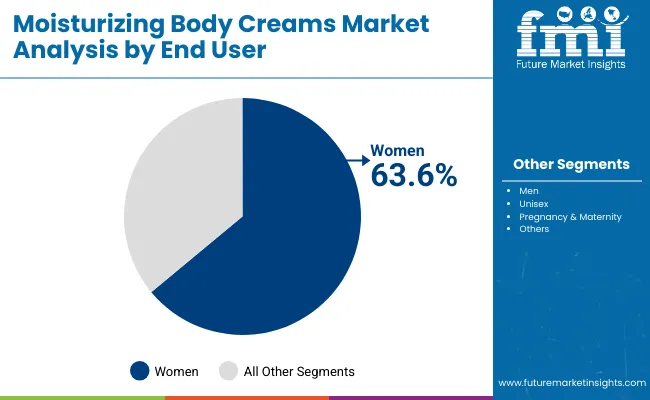
| End User | Value Share % 2025 |
|---|---|
| Women | 63.6% |
| Others | 36.4% |
The women’s segment is projected to contribute 63.6% of the Moisturizing Body Creams Market revenue in 2025, maintaining its position as the dominant consumer group. This leadership is driven by the growing preference for premium body care products enriched with natural ingredients such as shea butter, cocoa butter, and hyaluronic acid. Increasing awareness of skin health, self-care routines, and anti-aging benefits continues to shape buying behavior among women.
The segment’s growth is further supported by targeted product innovations, fragrance diversity, and digital beauty campaigns aimed at personalization. As e-commerce channels expand, women-led product categories are expected to remain the cornerstone of the Moisturizing Body Creams Market through 2035.
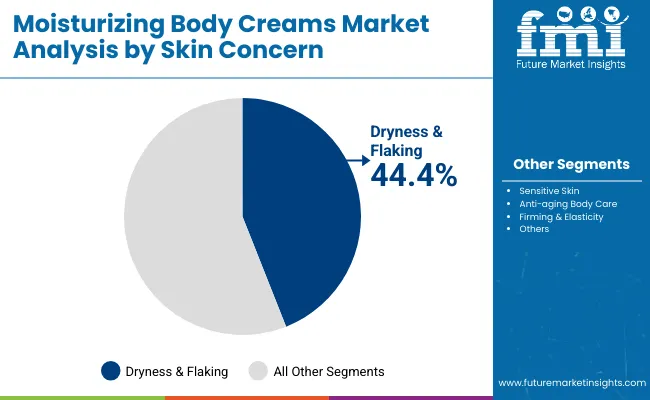
| Skin Concern | Value Share % 2025 |
|---|---|
| Dryness & flaking | 44.4% |
| Others | 55.6% |
The dryness and flaking segment is forecasted to hold 44.4% of the Moisturizing Body Creams Market share in 2025, driven by increasing consumer focus on deep hydration and barrier-repairing formulations. Products enriched with humectants and emollients such as glycerin, hyaluronic acid, and ceramides are gaining significant traction among consumers with dry and dehydrated skin.
The growing prevalence of climate-induced skin dryness and higher indoor pollution levels have accelerated the demand for rich body butters and hydrating creams. Continuous formulation improvements targeting long-lasting moisture retention and smooth skin texture will sustain the dominance of this segment through 2035.
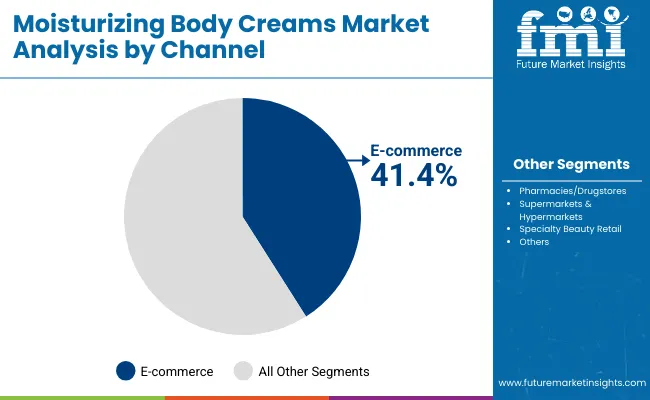
| Channel | Value Share % 2025 |
|---|---|
| E-commerce | 41.4% |
| Others | 58.6% |
The e-commerce segment is projected to account for 41.4% of the Moisturizing Body Creams Market revenue in 2025, establishing it as the fastest-growing distribution channel. This growth is driven by rising consumer preference for online beauty purchases, convenience, and access to a wider assortment of skincare products.
The surge in digital beauty platforms, influencer marketing, and subscription-based skincare models has amplified brand visibility and sales conversions. Furthermore, e-commerce channels enable seamless product comparisons and ingredient transparency, appealing to health-conscious and price-sensitive consumers alike. As personalization and AI-powered product recommendations advance, online sales are expected to remain the leading contributor to market expansion through 2035.
Rising Preference for Deep Hydration and Skin Barrier Protection The Moisturizing Body Creams Market is witnessing strong growth as consumers increasingly prioritize intensive hydration and skin barrier repair. Climate fluctuations, pollution exposure, and high urban stress levels have amplified the need for moisturizing products that restore skin resilience and prevent transepidermal water loss.
The popularity of formulations containing ceramides, shea butter, and hyaluronic acid continues to grow across both premium and mass segments. Additionally, post-shower body care routines and dermatological awareness campaigns are reinforcing the use of daily moisturizing products for maintaining long-term skin health.
Expansion of E-commerce and Premium Skincare Accessibility The rapid growth of online beauty retail is fueling the expansion of the Moisturizing Body Creams Market. E-commerce platforms now serve as the primary sales channel for both established and emerging skincare brands, offering extensive product variety, transparent ingredient listings, and convenience in purchase.
Social media influencers and digital skin assessments are reshaping purchase patterns by encouraging brand trials and repeat purchases. Global consumers are increasingly inclined toward premium and natural body creams that promise visible results, driving steady revenue growth across online platforms and omnichannel distribution networks.
Intense Price Competition and Product Saturation A key challenge in the Moisturizing Body Creams Market is the growing price competition among brands, particularly in the mid-range and mass segments. With a surge in new entrants and private-label alternatives, established brands face pressure to maintain margins while differentiating through innovation and marketing.
Product saturation across similar formulations reduces perceived uniqueness, forcing brands to invest heavily in packaging, branding, and sensory appeal. Furthermore, frequent promotional pricing and discounts in online channels can dilute long-term brand equity and hinder sustained profitability in the market.
Shift Toward Clean Label and Dermatologist-Tested Formulations A defining trend in the Moisturizing Body Creams Market is the accelerating shift toward clean-label, dermatologist-tested, and cruelty-free formulations. Consumers are increasingly scrutinizing ingredient transparency, preferring products free from parabens, sulfates, and synthetic fragrances.
This has led brands to reformulate with naturally derived emollients, plant-based oils, and skin-identical lipids that provide efficacy without irritation. Moreover, certifications such as “dermatologically approved” and “clinically tested” are becoming key purchase drivers. This trend is reshaping the competitive landscape, positioning science-backed natural formulations as the future growth engine for moisturizing body creams.
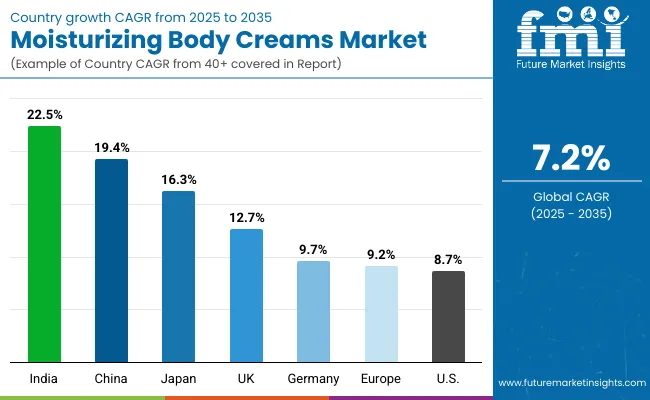
| Country | Estimated CAGR (2025 to 2035) |
|---|---|
| China | 19.4% |
| USA | 8.7% |
| India | 22.5% |
| UK | 12.7% |
| Germany | 9.7% |
| Japan | 16.3% |
The global Moisturizing Body Creams Market exhibits strong regional variations in adoption, primarily shaped by consumer awareness, climate conditions, retail infrastructure, and evolving skincare preferences. Asia-Pacific is the fastest-growing region, led by India (22.5%) and China (19.4%), driven by rising disposable incomes, urbanization, and a shift toward natural and herbal skincare products. Increasing digital engagement and rapid e-commerce expansion are further amplifying sales across urban and semi-urban markets.
Japan (16.3%) demonstrates high growth due to the adoption of ceramide-based and anti-aging formulations catering to mature skin demographics. In Europe, markets like the UK (12.7%) and Germany (9.7%) show stable progress, underpinned by consumer preference for dermatologically tested, sustainable, and eco-certified creams. The USA, with a CAGR of 8.7%, reflects a mature yet resilient market, where innovation in texture, inclusivity in branding, and clean-label launches continue to support long-term expansion.
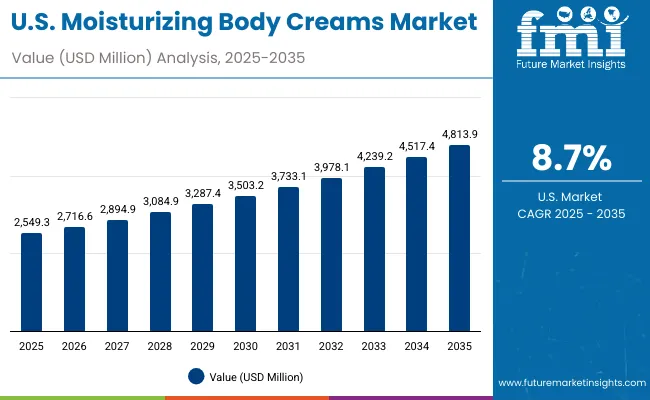
| Year | USA Moisturizing Body Creams Market (USD Million) |
|---|---|
| 2025 | 2549.3 |
| 2026 | 2716.6 |
| 2027 | 2894.9 |
| 2028 | 3084.9 |
| 2029 | 3287.4 |
| 2030 | 3503.2 |
| 2031 | 3733.1 |
| 2032 | 3978.1 |
| 2033 | 4239.2 |
| 2034 | 4517.4 |
| 2035 | 4813.9 |
The Moisturizing Body Creams Market in the United States is projected to grow at a CAGR of 8.7% between 2025 and 2035, driven by rising consumer focus on skin hydration, self-care routines, and dermatological health. Demand for premium, fragrance-free, and dermatologist-tested products is accelerating, particularly among urban consumers and aging populations.
E-commerce expansion, coupled with strong brand positioning through influencer-led campaigns, continues to reshape retail dynamics. Clean-label and hypoallergenic formulations are increasingly influencing purchasing decisions, while sustainability commitments and cruelty-free certifications are enhancing brand credibility and loyalty across millennial and Gen Z buyers.
The Moisturizing Body Creams Market in the United Kingdom is expected to grow at a CAGR of 12.7% between 2025 and 2035, supported by increasing consumer interest in premium, dermatologically tested, and sustainably sourced skincare products. British consumers are showing a strong inclination toward rich body butters and hydrating creams that address dryness, sensitivity, and loss of elasticity caused by colder climates.
Brands emphasizing clean-label, vegan, and cruelty-free credentials are rapidly gaining traction across both e-commerce and specialty retail. In addition, the rise of personalized skincare through AI-based skin assessments and subscription models is reshaping retail engagement. Collaborative innovation programs between beauty brands and dermatology institutions are further strengthening consumer trust and transparency in product efficacy.
India is witnessing rapid growth in the Moisturizing Body Creams Market, which is forecast to expand at a CAGR of 22.5% through 2035. The surge in demand is driven by a rising middle-class population, urbanization, and growing awareness of skincare as part of daily wellness routines.
Tier-2 and Tier-3 cities are emerging as key consumption hubs, fueled by affordable product launches, wider retail availability, and digital marketing outreach. Ayurvedic and herbal formulations featuring natural ingredients such as shea butter, aloe vera, and coconut oil are particularly popular among consumers seeking safe, non-irritant moisturizers. The expansion of organized retail and e-commerce platforms like Nykaa, Amazon, and Flipkart has further improved accessibility.
The Moisturizing Body Creams Market in China is expected to grow at a CAGR of 19.4%, the highest among leading economies. This strong momentum is supported by the country’s rapidly expanding beauty and personal care sector, rising disposable incomes, and growing consumer awareness of skincare health. Local brands are competing aggressively with international players by offering affordable yet high-quality moisturizing creams featuring ingredients like hyaluronic acid, ceramides, and plant-based emollients.
E-commerce giants such as Tmall and JD.com are facilitating direct-to-consumer sales, making moisturizing products more accessible to younger demographics. The surge in social media beauty influencers, coupled with livestreaming-based retail strategies, is amplifying consumer reach and brand loyalty.
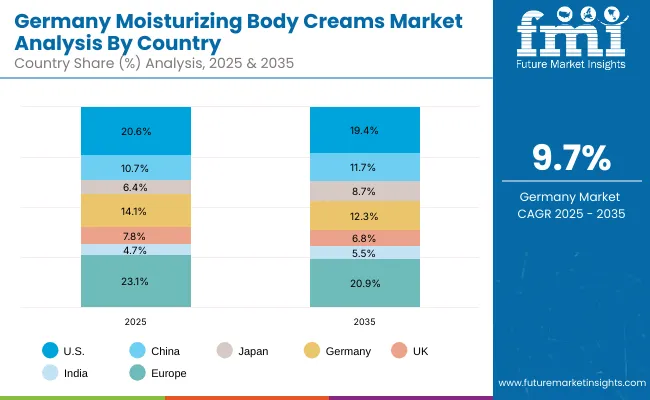
| Country | 2025 Share (%) |
|---|---|
| USA | 20.6% |
| China | 10.7% |
| Japan | 6.4% |
| Germany | 14.1% |
| UK | 7.8% |
| India | 4.7% |
| Country | 2035 Share (%) |
|---|---|
| USA | 19.4% |
| China | 11.7% |
| Japan | 8.7% |
| Germany | 12.3% |
| UK | 6.8% |
| India | 5.5% |
The Moisturizing Body Creams Market in Germany is projected to grow at a CAGR of 9.7% through 2035, reflecting stable consumer demand within one of Europe’s most mature skincare markets. German consumers show strong preferences for dermatologically tested, fragrance-free, and clinically validated formulations, aligning with the country’s emphasis on product safety and efficacy.
Established pharmaceutical and dermocosmetic brands dominate, offering advanced moisturizing creams designed for sensitive and dry skin conditions. The market also benefits from high retail penetration across pharmacies, drugstores, and premium beauty outlets. Sustainable packaging, vegan-certified formulations, and transparency in ingredient sourcing are key growth drivers.
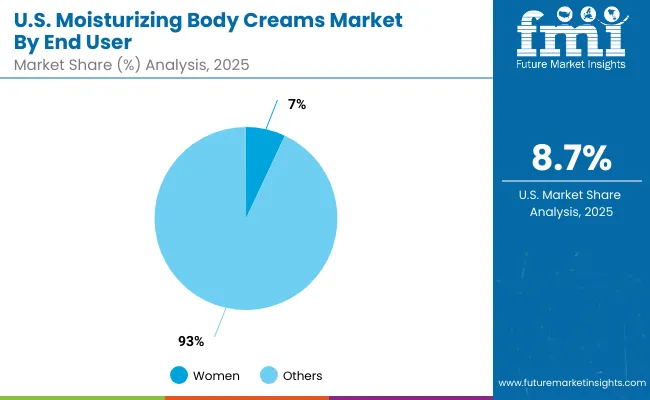
| USA by End User | Value Share % 2025 |
|---|---|
| Women | 6.6% |
| Others | 93.4% |
The Moisturizing Body Creams Market in the United States is projected to reach USD 2,549.3 million in 2025, led by broad adoption across gender-neutral and mass skincare categories. The dominant “Others” segment (93.4%) indicates the strong appeal of multifunctional and unisex moisturizing formulations tailored for all skin types.
Growth is supported by heightened awareness of skin health, expanding product accessibility across drugstores and online platforms, and a rising preference for fragrance-free and dermatologist-recommended brands. Furthermore, innovations in texture, fast absorption, and skin barrier repair are reshaping consumer expectations. Premium and natural product lines featuring clean ingredients and sustainable packaging continue to strengthen brand loyalty among health-conscious consumers.
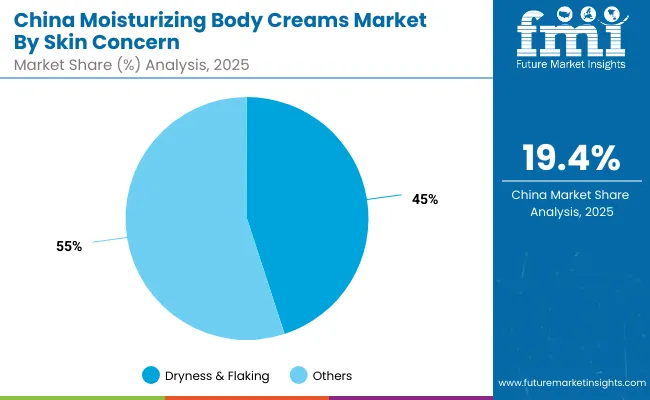
| China by Skin Concern | Value Share % 2025 |
|---|---|
| Dryness & flaking | 45.3% |
| Others | 54.7% |
The Moisturizing Body Creams Market in China presents significant growth opportunities, driven by the country’s evolving skincare preferences, digital retail dominance, and local brand innovation. With 45.3% of consumers targeting dryness and flaking, hydration-focused creams infused with hyaluronic acid, ceramides, and glycerin are in high demand.
Rapid urbanization, pollution exposure, and changing climate patterns have increased the need for daily moisturizing routines among both men and women. The growing influence of K-beauty and J-beauty trends is reshaping product aesthetics and packaging, while e-commerce platforms such as Tmall and Douyin continue to amplify visibility and cross-border product access.
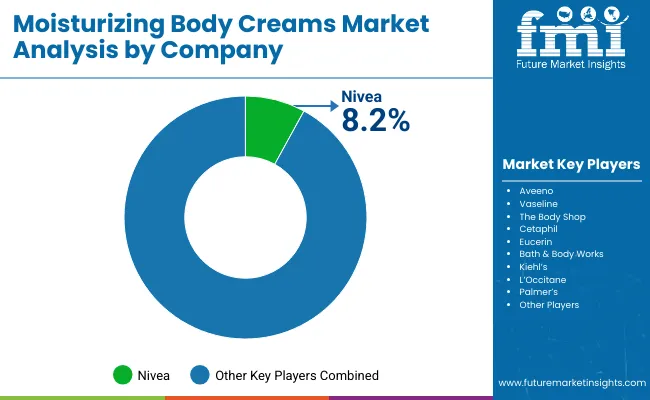
| Company | Global Value Share 2025 |
|---|---|
| Nivea | 8.2% |
| Others | 91.8% |
The Moisturizing Body Creams Market is moderately fragmented, with global leaders, regional brands, and niche skincare specialists competing across varied consumer segments. Leading brands such as Nivea, Aveeno, and Vaseline dominate global market share, supported by strong distribution networks, heritage branding, and consistent investment in R&D for advanced moisturizing formulations. These companies are expanding their product lines with dermatologist-tested, fragrance-free, and sustainability-certified creams to maintain market leadership.
Mid-tier brands such as The Body Shop, Cetaphil, and Eucerin focus on skin sensitivity and hydration efficacy, introducing clinically validated products through pharmacies and online channels. Emerging players like Kiehl’s, L’Occitane, and Palmer’s emphasize natural, ethically sourced ingredients and eco-friendly packaging to attract younger, sustainability-driven consumers.
Competitive differentiation is shifting from brand legacy toward ingredient innovation, digital engagement, and clean-label transparency. E-commerce expansion, influencer marketing, and personalized skincare recommendations are redefining competition, with data-driven marketing and subscription models gaining momentum. The evolving balance between clinical efficacy, sensory experience, and ethical production continues to shape brand positioning across both mass and premium moisturizing categories.
Key Developments in Moisturizing Body Creams Market
| Item | Value |
|---|---|
| Quantitative Units | USD 12,402.8 Million |
| Product Type | Rich body butters, Hydrating body lotions, Repair creams, Overnight body masks |
| Key Ingredients | Shea butter, Cocoa butter, Hyaluronic acid, Ceramides, Glycerin |
| Skin Concern | Dryness & flaking, Sensitive skin, Anti-aging body care, Firming & elasticity |
| Channel | E-commerce, Pharmacies/drugstores, Supermarkets & hypermarkets, Specialty beauty retail |
| End User | Women, Men, Unisex, Pregnancy & maternity |
| Regions Covered | North America, Europe, Asia-Pacific, Latin America, Middle East & Africa |
| Country Covered | United States, Canada, Germany, France, United Kingdom, China, Japan, India, Brazil, South Africa |
| Key Companies Profiled | Nivea, Aveeno, Vaseline, The Body Shop, Cetaphil, Eucerin, Bath & Body Works, Kiehl’s, L’Occitane, Palmer’s |
| Additional Attributes | Dollar sales by product type and key ingredient, adoption trends in hydration-focused and anti-aging skincare, rising demand for dermatologically tested and fragrance-free formulations, segment-specific growth across women’s, men’s, and maternity care, channel-based revenue segmentation highlighting e-commerce expansion, integration of AI-driven skin diagnostics and personalized skincare tools, regional trends shaped by urbanization and self-care awareness, and ongoing innovations in clean-label, ceramide-rich, and hyaluronic acid-based moisturizing formulations. |
The global Moisturizing Body Creams Market is estimated to be valued at USD 12,402.8 million in 2025.
The market size for the Moisturizing Body Creams Market is projected to reach USD 24,806.4 million by 2035.
The Moisturizing Body Creams Market is expected to grow at a 7.2% CAGR between 2025 and 2035.
The key product types in the Moisturizing Body Creams Market are rich body butters, hydrating body lotions, repair creams, and overnight body masks.
In terms of skin concern, the dryness & flaking segment is expected to command a 44.4% share in the Moisturizing Body Creams Market in 2025, driven by strong consumer demand for deep hydration and barrier-repairing formulations.






Our Research Products

The "Full Research Suite" delivers actionable market intel, deep dives on markets or technologies, so clients act faster, cut risk, and unlock growth.

The Leaderboard benchmarks and ranks top vendors, classifying them as Established Leaders, Leading Challengers, or Disruptors & Challengers.

Locates where complements amplify value and substitutes erode it, forecasting net impact by horizon

We deliver granular, decision-grade intel: market sizing, 5-year forecasts, pricing, adoption, usage, revenue, and operational KPIs—plus competitor tracking, regulation, and value chains—across 60 countries broadly.

Spot the shifts before they hit your P&L. We track inflection points, adoption curves, pricing moves, and ecosystem plays to show where demand is heading, why it is changing, and what to do next across high-growth markets and disruptive tech

Real-time reads of user behavior. We track shifting priorities, perceptions of today’s and next-gen services, and provider experience, then pace how fast tech moves from trial to adoption, blending buyer, consumer, and channel inputs with social signals (#WhySwitch, #UX).

Partner with our analyst team to build a custom report designed around your business priorities. From analysing market trends to assessing competitors or crafting bespoke datasets, we tailor insights to your needs.
Supplier Intelligence
Discovery & Profiling
Capacity & Footprint
Performance & Risk
Compliance & Governance
Commercial Readiness
Who Supplies Whom
Scorecards & Shortlists
Playbooks & Docs
Category Intelligence
Definition & Scope
Demand & Use Cases
Cost Drivers
Market Structure
Supply Chain Map
Trade & Policy
Operating Norms
Deliverables
Buyer Intelligence
Account Basics
Spend & Scope
Procurement Model
Vendor Requirements
Terms & Policies
Entry Strategy
Pain Points & Triggers
Outputs
Pricing Analysis
Benchmarks
Trends
Should-Cost
Indexation
Landed Cost
Commercial Terms
Deliverables
Brand Analysis
Positioning & Value Prop
Share & Presence
Customer Evidence
Go-to-Market
Digital & Reputation
Compliance & Trust
KPIs & Gaps
Outputs
Full Research Suite comprises of:
Market outlook & trends analysis
Interviews & case studies
Strategic recommendations
Vendor profiles & capabilities analysis
5-year forecasts
8 regions and 60+ country-level data splits
Market segment data splits
12 months of continuous data updates
DELIVERED AS:
PDF EXCEL ONLINE
Body Firming Creams Market Growth & Forecast 2025-2035
Coconut Oil Moisturizing Creams Market Analysis - Size, Share, and Forecast Outlook 2025 to 2035
Moisturizing Skincare Products Market Size and Share Forecast Outlook 2025 to 2035
Moisturizing Agents Market Size and Share Forecast Outlook 2025 to 2035
Body Armor Plates Market Size and Share Forecast Outlook 2025 to 2035
Body Composition Monitor and Scale Market Size and Share Forecast Outlook 2025 to 2035
Body Tape Market Size and Share Forecast Outlook 2025 to 2035
Body Blurring Cosmetics Market Size and Share Forecast Outlook 2025 to 2035
Body Contouring Market Size and Share Forecast Outlook 2025 to 2035
Body Fat Reduction Market Growth - Trends & Forecast 2025 to 2035
Body Armor Market Analysis - Size, Share & Forecast 2025 to 2035
Body-Worn Temperature Sensors Market Analysis by Type, Application, and Region through 2025 to 2035
Body Fat Measurement Market Analysis - Trends, Growth & Forecast 2025 to 2035
Body Slimming Devices Market Analysis by Product, End-User and Region through 2035
Leading Providers & Market Share in Body Augmentation Fillers
Body Scrub Market Growth & Forecast 2025 to 2035
Body Luminizer Market Trends & Forecast 2025 to 2035
Body Dryer Market
Body In White Market
Antibody Market Size and Share Forecast Outlook 2025 to 2035

Thank you!
You will receive an email from our Business Development Manager. Please be sure to check your SPAM/JUNK folder too.
Chat With
MaRIA